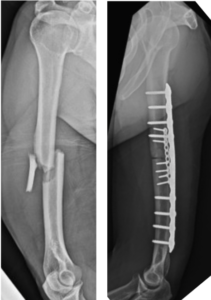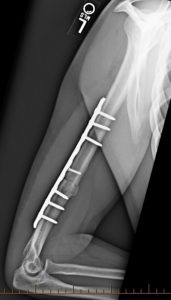Humeral Shaft Fracture
What is a Humeral Shaft Fracture?
A humeral shaft fracture is a break of the upper arm bone. This occurs along the long portion of the bone between the shoulder and elbow joints. These fractures usually result from high energy injuries such as car accidents in younger patients and most often from falls in the elderly patient. The humerus can be broken into many pieces or just crack slightly depending on the quality of bone and the type of injury.
What does the Humerus do?
The humerus is an important bone because it supports your arm in space for activity. It is a vital part of the shoulder and elbow joints. Many important muscles also attach to this bone which help chest and arm muscles work properly.
Diagnosis and Examination
Physical examination is important in the evaluation of these injuries. Important nerves and blood vessels run next to this bone and can be injured when it breaks. The radial nerve helps to extend your wrist and fingers, and can be injured when the bone breaks. The doctor will ask you to move your fingers and wrist during the exam. It may feel like torture, but it is an important part of the exam process. The doctor will look for any open wounds over the injury as these usually require surgery.
X-rays are used to evaluate the location and severity of the broken bone. This helps doctors and patients make an informed decision on treatment. Often two or more x-rays are taken to show the injury pattern.

Pre and postoperative xray of humeral shaft fracture.
Non-Surgical Treatment for Humeral Shaft Fractures
Many types of humeral shaft fractures can be treated without surgery. In the beginning some patients are splinted with a large U-shaped splint called a coaptation splint. This is often done in local emergency rooms or urgent care facilities. Long term treatment is usually done with a Sarmiento or fracture brace. This is a plastic brace with Velcro that is fit to the arm by our cast technicians and can be adjusted. A sling is often provided for comfort and support as well. In the brace, patients can use their arm to lift light objects, brush hair and teeth and perform simple activities of daily living.
If non-operative care is chosen, regular follow-up care for a physical exam and x-rays is important to ensure that the fracture stays in good position and heals appropriately. Cutting down or quitting smoking and tight blood sugar control if you are a diabetic is important for the healing process. One fall or continued lack of compliance with bracing can pull the bone ends apart and result in the need for surgery.
Depending on health and injury pattern this bone can take 3-4 months to heal without surgery. In the initial few weeks, humeral shaft fractures treated without surgery tend to be painful or uncomfortable until the healing process matures over a few weeks. Physical therapy for shoulder and elbow range of motion is started around six weeks once bone has healed enough to prevent displacement with motion.
Surgical Treatment for Broken Arms
Surgeons may recommend an operation to fix the broken arm if the pieces are displaced, if the arm is extremely painful or deformed. There are several scientific studies showing that patient can return to manual labor type jobs sooner if they undergo surgical treatment.
The humerus can be fixed with metal plates and screws placed through large incisions or intramedullary nails which use small incisions. The type of fracture usually dictates what type of metal and surgery needs to be done. Most trauma surgeons tend to use plates and screws because healing rates are better and the risk of nerve injuries are less. The incision is usually 10 to 15 centimeters long and can be placed on the front or back of the arm. Intramedullary nails are usually reserved for pathologic fractures due to metastatic cancer since their use can damage the rotator cuff tendons. It has a higher nerve injury rate and non-union rate. Surgery usually takes 1 to 2 hours and can be done on an outpatient basis and patients can go home the same day. Ideally, surgeons like to perform this surgery within 1-2 weeks of injury. Thus, patients have time to seek a second opinion regarding treatment if more information or additional surgeon input is desired.
It is important to choose your surgeon wisely. Extensive surgical experience can be helpful in achieving a good result and avoiding complications. Collectively, ROC surgeons have performed more humerus operations than any practice in Northern Nevada and take pride in outstanding surgical results.
After surgery, patients do not require any brace, splint or cast and can use the arm immediately. If a patient had a nerve injury prior to surgery, a wrist brace may be utilized to prevent muscle contracture. Gentle motion is begun early to prevent stiffness. Gradually this motion is increased and physical therapy is begun around 3-6 weeks after surgery.
Surgical Complications
Complications can occur with any surgery, no matter how small. There is always a risk of infection. A dose of antibiotics given prior to surgery helps to make this risk as small as possible. There is always a risk of injury to blood vessels or nerves. This is reduced by having an experienced surgeon involved in your care. Non-compliance with weight bearing restrictions, too much motion or falls can result in the metal ripping out of the bone or the fracture separating. It is always possible that the bone may not heal and additional surgery will be required. This is usually associated with patient non-compliance, diabetes, or use of nicotine like smoking and chewing tobacco.
Outcomes

Postoperative Humeral Shaft Fracture
Most people with humeral shaft fractures do very well and return to prior activities and function. By six weeks, patients are extremely comfortable and usually are released to full activities such as manual labor, skiing and motocross by three months. Aggressive return to activity too early can result in re-fracture, hardware breakage or non-union.